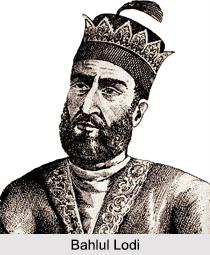 Bahlul Lodi was the founder of the Lodi Dynasty and ruled for long 39 years (1451-89). He was the Governor of Lahore and Sirhind during the rule of Muhammad Shah of Sayyid dynasty. Bahlul Lodi was not only the founder of the Lodhi dynasty but was responsible for its strength and glory. He was successful in subduing the various chiefs who could defy the central power.
Bahlul Lodi was the founder of the Lodi Dynasty and ruled for long 39 years (1451-89). He was the Governor of Lahore and Sirhind during the rule of Muhammad Shah of Sayyid dynasty. Bahlul Lodi was not only the founder of the Lodhi dynasty but was responsible for its strength and glory. He was successful in subduing the various chiefs who could defy the central power.
Bahlul Lodi proved to be a capable commander. He was a courageous soldier and a successful general. He was realist but cunning as well. He believed in the saying that the end justified the means and therefore did not hesitate to have recourse to treachery or fraud when necessary to achieve his objective. Bahlul was diplomatic, possessed common sense and was well aware of his limitations and circumstances. He was a laborious, courageous, honest, kind-hearted and a religious minded person. It is said that never a beggar or a poor was turned away from his gate without some offering. He was friendly to everybody. He always respected scholars and religious persons. He was intelligent and witty. Bahlul practiced the principles of Islam in his personal life but pursued a tolerant policy towards his Hindu subjects.
Early Life of Bahlul Lodi
Bahlul Lodi belonged to the Shahu Khel clan of the Lodis which was an important branch of the Afghans. He was born to a Pashtun family. In 1419, Bahlul was brought up by his uncle Islam Khan who had taken up service under the Sayyid ruler, Khizr Khan. After the death of Islam Khan, Bahlul became the Governor of Sarhind. His primary task was to restore back the lost prestige of the Sultan, to establish the supremacy of the Afghans in the kingdom, to suppress the rebellious nobles and jagirdars, to safeguard his kingdom from jealous neighbours and to consolidate his gains.
Rule of Bahlul Lodi
Bahlul Lodi went on increasing his power and influence and was awarded the title of "Khan-i-Jahan" and also possession of Punjab. Sultan Ala-ud-din Alam was the last ruler of the Sayyid Dynasty and after him Bahlul ascended the throne on 19th April 1451 A.D. When he ascended the throne, the territory of the Sultanate extended only up to Palam and a few miles around Delhi. But, by the time he reached his ripe age of 80 years, his empire extended from the frontiers of Bihar and included important cities like Baran, Sambhal, Rapri etc. A part of Rajasthan was under him and the rulers of Gwalior, Dholpur and Bari paid tribute to him. Prior to his accession to the throne his weak predecessors had succeeded only in destroying the power and prestige of the Delhi Sultanate.
Conquests of Bahlul Lodi
Bahlul Lodi undertook a series of military expeditions on Mewar, Sambhal, Rapri, Bhogaon, Gwalior etc. and forced the chiefs to offer submission and pay annual tribute. One remarkable success of Bahlul was the conquest of Jaunpur. Mahmud Shah Sharqi, the ruler of Jaunpur married a daughter of the Sayyid Sultan, Ala-ud-din Alam. Mahmud Shah attacked Delhi in the very first year of the reign of Bahlul but was ultimately defeated. Bahlul annexed the kingdom of Jaunpur and appointed, Barbak Shah as its ruler. The conquest of Jaunpur proved his military competency and added to his resources and raised his prestige among the rulers. It enabled him to compel the Chiefs of Kalpi, Dholpur and Alipur to acknowledge his suzerainty. He attacked Gwalior during the last year of his reign. Bahlul Lodi proved himself a capable ruler. It was due to his exertion of military talents that the Lodi dynasty could find a place in the history of the Delhi Sultanate.
Successor of Bahlul Lodi
Bahlul Lodi achieved much for his dynasty and prepared the way further for his son and successor, Sikandar Lodi. He died in l489, near the town of Jalali. His tomb is located adjacent to the shrine of the famous Sufi saint, Nasiruddin Chirag-e-Delhi, in Delhi.



















